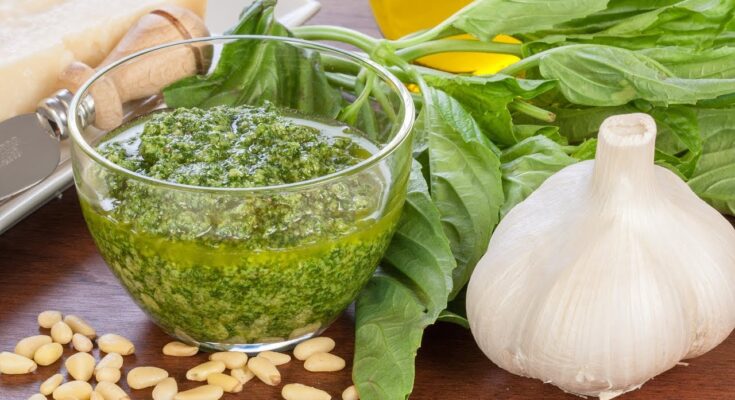Best Pesto Recipe: Pesto is a rich, green sauce originating from Italy that has captured the hearts (and stomachs) of food lovers around the world. Traditionally made with fresh basil, garlic, pine nuts, Parmesan cheese, and olive oil, it’s a bold, aromatic blend that’s both savory and satisfying. Its name comes from the Italian word pestare, which means “to pound” or “crush,” reflecting its original preparation with a mortar and pestle.
What makes pesto truly special is its vibrant flavor and versatile usage. Whether spread on sandwiches, swirled into pasta, or used as a marinade, this green sauce delivers a punch of taste that elevates any dish. It’s easy to make, quick to prepare, and requires no cooking—perfect for busy days or when you want to impress guests with minimal effort.
History and Origin of Pesto
Pesto’s roots run deep into the culinary traditions of Liguria, a coastal region in northwestern Italy. Genoa, the capital of Liguria, is credited with the creation of this now globally beloved sauce. The earliest versions of pesto date back to Roman times, where a similar green paste called moretum was used. Over centuries, it evolved with regional ingredients into what we now recognize as pesto alla Genovese.
What sets Genoese pesto apart is its use of small-leaf basil from the region, which thrives in Liguria’s Mediterranean climate. The traditional method uses a mortar and pestle to grind the ingredients gently, preserving their natural oils and releasing their full flavor. While modern technology has made it easier to prepare pesto, many purists still argue that the traditional method delivers a deeper, more authentic taste.
Why Homemade Pesto Is Better Than Store-Bought
There’s no denying that store-bought pesto offers convenience, but once you’ve tried homemade pesto, it’s hard to go back. Store-bought versions often contain preservatives, added sugars, or oils that dilute the fresh taste of basil and garlic. They might also use cheaper nuts like cashews instead of pine nuts and powdered cheese instead of freshly grated Parmesan.
Homemade pesto, on the other hand, allows you to control every ingredient that goes into it. You get to pick fresh basil, use high-quality olive oil, and adjust the salt and garlic levels to your liking. The result? A sauce that’s vibrant, flavorful, and customized to your palate. Plus, making it at home is surprisingly fast—just five to ten minutes from start to finish!
Ingredients Needed for Classic Basil Pesto
Fresh Ingredients Make the Difference
Here’s what you’ll need for an authentic basil pesto:
- Fresh Basil Leaves (2 cups packed): Look for bright green, unblemished leaves.
- Pine Nuts (1/3 cup): Toast lightly to enhance their nutty flavor.
- Garlic (2-3 cloves): Fresh cloves give that sharp, pungent kick.
- Parmesan Cheese (1/2 cup, grated): Use high-quality Parmigiano-Reggiano for best results.
- Extra Virgin Olive Oil (1/2 cup): Choose cold-pressed for a richer flavor.
- Salt (to taste): Sea salt or kosher salt works best.
- Optional: A squeeze of lemon juice for brightness.
Each ingredient plays a role in the pesto’s texture and taste, and the quality of what you use really shows in the final product. Always opt for fresh and organic if possible—it truly makes a world of difference.
Substitutes and Variations for Common Ingredients
Can’t find pine nuts? No worries. Walnuts, almonds, or even sunflower seeds can be used as alternatives. Each brings a slightly different flavor profile—walnuts offer a bolder, earthier taste, while almonds are a bit sweeter. For a dairy-free option, try using nutritional yeast instead of cheese.
Not a fan of basil? Spinach, arugula, or kale can be used for a different twist, especially when basil is out of season. These greens are packed with nutrients and pair well with the other classic pesto components.
For a spicier kick, add a pinch of red pepper flakes or a fresh chili. Want it more zesty? A dash of lemon zest will do the trick. The beauty of pesto is its flexibility—it’s a base recipe that welcomes your personal touch.
Step-by-Step Pesto Recipe Guide
Step 1 – Gathering Ingredients
Before you start, make sure you have all your ingredients measured and prepped. Freshness is key, so avoid wilted basil or old garlic. Toast your pine nuts in a dry pan over medium heat for 2-3 minutes until golden brown—this brings out their flavor and makes a big difference in the final sauce.
Also, grate your Parmesan cheese finely. The finer the grate, the smoother it will blend into your pesto. Once everything’s ready, it’s time to move on to prep.
Step 2 – Prepping Basil and Garlic
The preparation phase is crucial to achieving that signature pesto flavor. Start with thoroughly washing your basil leaves under cold water. Pat them dry using a paper towel or a salad spinner. It’s essential they’re dry before blending—too much water can make your pesto watery and dull in flavor.
Next, peel your garlic cloves. For a milder garlic flavor, you can roast them lightly in a pan for a few minutes, but traditional pesto uses raw garlic for that classic sharp bite. The size and freshness of the garlic cloves also matter—a larger, fresh clove tends to have a more balanced flavor, while smaller or aged ones might be overpowering.
Some chefs recommend chopping the garlic slightly before blending to ensure it breaks down evenly. This is especially useful if you’re using a mortar and pestle, as it reduces the pounding time.
Step 3 – Blending and Mixing
Now, it’s time for the magic to happen. If you’re using a food processor or blender, add the basil, toasted pine nuts, and garlic first. Pulse these ingredients together a few times until they are coarsely chopped. Don’t overblend here—you want texture, not a paste.
Next, add in the grated Parmesan cheese and a pinch of salt. Slowly pour in the olive oil while the processor is running. This slow addition emulsifies the mixture, giving it that creamy, cohesive texture pesto is known for.
For those going old-school with a mortar and pestle, add the garlic and salt first. Pound until smooth. Add pine nuts and continue pounding. Then, add basil leaves gradually, grinding them in circular motions until everything is broken down. Add cheese last, and stir in olive oil slowly.
Regardless of the method, the goal is a thick but spoonable consistency that’s not too runny or too chunky. It should cling to a spoon but not drip like soup.
Step 4 – Adjusting Texture and Flavor
Once your pesto is blended, it’s time to tweak it to perfection. Taste it—does it need more salt? Perhaps a touch more garlic? Maybe a drizzle more olive oil to smooth it out?
Here are a few tips:
- Too thick? Add a tablespoon of olive oil or a splash of water to loosen it.
- Too bitter? Try adding a small squeeze of lemon juice or a touch more Parmesan to balance the flavor.
- Too bland? A pinch more salt or another clove of garlic might do the trick.
The secret to great pesto is balance. Each ingredient should stand out, but none should overpower. It should be vibrant, garlicky, and slightly nutty, with a cheesy undertone and a rich olive oil finish.
Step 5 – Storing Your Pesto Properly
Freshly made pesto is a delight, but what if you want to store it for later? Here’s how:
- Short-term: Store in an airtight container in the refrigerator for up to one week. To prevent oxidation and maintain the bright green color, drizzle a thin layer of olive oil over the surface before sealing the container.
- Long-term: Pesto freezes beautifully. Spoon it into an ice cube tray, freeze until solid, then transfer the cubes to a freezer bag. Each cube is about one serving—perfect for tossing into pasta, soups, or spreads as needed.
Avoid heating pesto directly on high heat, as it can ruin the texture and cause the basil to turn brown. Instead, add it to dishes after cooking or just before serving to keep its flavor fresh and vibrant.
Tips to Elevate Your Pesto Game
Secret Techniques from Chefs
Professional chefs often tweak traditional pesto for a more refined result. Some techniques include:
- Using a mortar and pestle for a rustic, authentic texture.
- Blanching basil leaves briefly in boiling water and plunging them into ice water to preserve the green color.
- Mixing oils: Blend olive oil with a touch of neutral oil like grapeseed to smooth out the flavor.
- Aged cheeses: Combine Parmesan with Pecorino Romano for a sharper kick.
These subtle changes can dramatically enhance your pesto, especially when serving at dinner parties or special occasions.
Common Mistakes to Avoid
Even a simple sauce like pesto can go wrong if you’re not careful. Here are a few things to avoid:
- Over-processing: This can turn your pesto into a lifeless green mush.
- Using bitter olive oil: Not all olive oils are created equal. Choose a smooth, buttery one for the best results.
- Skipping the salt: Salt enhances flavor. Even if your cheese is salty, you might still need a bit more.
- Using old ingredients: Freshness matters. Old garlic or wilted basil will ruin the taste.
Stick to fresh, high-quality ingredients, and your pesto will always shine.
FAQs about the Best Pesto Recipe
1. What is pesto made of?
Traditional pesto is made with fresh basil, garlic, pine nuts, Parmesan cheese, and extra virgin olive oil. However, you can customize it with ingredients like walnuts, arugula, or even sun-dried tomatoes for a unique twist.
2. How do I store homemade pesto?
Store homemade pesto in an airtight container in the refrigerator for up to a week. For longer storage, freeze it in small portions, like in an ice cube tray, for easy use later.
3. Can I make pesto without a food processor?
Yes, you can use a blender or even a mortar and pestle for a more authentic, rustic texture. Just be sure to add the ingredients gradually for the best consistency.
4. What dishes can I use pesto for?
Pesto is incredibly versatile. Use it as a pasta sauce, pizza topping, sandwich spread, salad dressing, or even a marinade for meats and veggies.
5. Is pesto vegan-friendly?
Traditional pesto contains Parmesan cheese, but you can easily make it vegan by using nutritional yeast or a dairy-free cheese substitute.
Conclusion
Pesto is more than just a sauce—it’s a celebration of fresh ingredients, a tribute to Italian heritage, and a versatile flavor bomb that can transform any meal. Making it at home isn’t just easy; it’s also deeply satisfying. From pasta and pizzas to sandwiches and soups, the uses are endless. Once you try this homemade version, you’ll never reach for a store-bought jar again.



